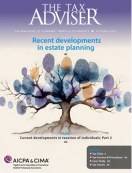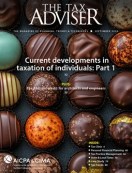The IRS issued final regulations governing how an S corporation reduces its tax attributes under Sec. 108(b) when the S corporation has discharge of indebtedness income that is excluded from gross income under Sec. 108(a).
S Corporation Income Taxation
C Corporations as S Corporation Subsidiaries
An S corporation can elect to treat a 100% owned subsidiary as a qualified subchapter S subsidiary (QSub), which causes the subsidiary to be disregarded for most federal tax purposes. The subsidiary must be a corporation that would be eligible to be an S corporation if the shareholders of its parent S corporation held its stock directly.
Recognizing When an S Corporation Has Accumulated Earnings and Profits
Both a C corporation and an S corporation can distribute taxable dividends to the extent that the corporation has accumulated earnings and profits (AE&P). An S corporation cannot generate earnings and profits (E&P) but a C corporation’s AE&P transfers to the S corporation when the S election is made.
Recapture of Sec. 179 Expense Deduction for Passthrough Entities
How to report the recapture of Sec. 179 expense for passthrough entities at both the entity and owner levels.
Current Developments in S Corporations (Part II)
This article discusses S corporation eligibility, elections, and termination issues. It covers significant topics related to a second class of stock, trusts owning S corporation stock, and an interesting ruling on the reelection of S status.
Current Developments in S Corporations (Part I)
This two-part article discusses recent legislation, cases, rulings, regulations, and other developments in the S corporation area. Part I covers operational issues; part II, in the November issue, will cover S corporation eligibility, elections, and termination issues.
Avoiding S Corporation Debt Obligations That Are a Second Class of Stock
Under certain circumstances, debt owed by an S corporation to one or more shareholders will be a second class of stock.
Revenue Ruling on S Elections for Partnerships Converting to Corporations
The IRS has issued a revenue ruling that addresses the question of whether, when a partnership becomes a corporation for federal tax purposes, it is eligible to elect to be taxed as an S corporation in its first tax year.
Recent Amendment to Sec. 1374 Provides Limited Opportunity for S Corps.
An amendment to Sec. 1374(d) provides a temporary exemption from the application of Sec. 1374 to sales of assets in 2009 and 2010, but only for S corporations that meet certain requirements.
Economic Outlay Revisited
Under the economic outlay doctrine, to obtain basis in an S corporation with respect to debt, a shareholder must make an actual economic outlay, the outlay must somehow leave the shareholder poorer in a material sense, and the debt created must run directly between the shareholder and the S corporation.
Distressed S Corporations: Tax Issues Involved in Restructuring
This article highlights tax issues and planning opportunities that may arise relative to a distressed S corporation, its shareholders, and its creditors.
S Corporation Tax Year Rules
The use of a fiscal year defers reporting of the S corporation’s passthrough income to the shareholders and facilitates year-end tax planning.
Final Sec. 1367 Regs. Address Open Account Debt Between S Corps. and Their Shareholders
Final regulations (T.D. 9428) amend the definition of open account debt, which may significantly affect when an S corporation shareholder recognizes gain on the repayment of such debt.
Allocating Passthrough Items to S Corporation Shareholders
Passthrough items from an S corporation are allocated on a per-share, per-day basis (Sec. 1377(a)(1)).
Guidance on S Corporation Life Insurance Premiums Raises Questions
The IRS recently issued long-awaited guidance on the treatment of life insurance premiums paid and life insurance proceeds received by an S corporation.
Current Developments in S Corporations (Part II)
This article discusses S corporation eligibility, elections, and termination issues, including guidance for changes made by the American Jobs Creation Act of 2004 and the Gulf Opportunity Zone Act of 2005 , significant issues related to second class of stock, and a notice that provides a simplified method to make an S election.
S Corporation Sale of Assets Followed by a Liquidation
This item focuses on the specific tax implications to the seller of the sale of an S corporation’s assets followed by a liquidation or a deemed asset sale followed by a liquidation.
Current Developments in S Corporations (Part I)
This two-part article discusses recent legislation, cases, rulings, regulations, and other developments in the S corporation area. Part I covers operational issues, including new guidance on the treatment of medical insurance premiums for wholly owned S corporations, new built-in gain developments, and the impact of charitable giving by S corporations on shareholders’ adjusted basis in stock.
S Corporation Shareholder Loans: A Cautionary Tale
A practitioner should take special care in advising clients on shareholder loans to an S corporation. Repayment of the loans by the corporation has the potential to generate unexpected taxable income to the shareholder.
Qualifying a Marital Deduction Trust as an Eligible S Shareholder
The marital deduction permits the estate of the spouse who dies first to claim an estate tax deduction for property passing to the surviving spouse if certain requirements are met.
TAX PRACTICE MANAGEMENT
2025 tax software survey
AICPA members in tax practice assess how their return preparation software performed during tax season and offer insights into their procedures.














